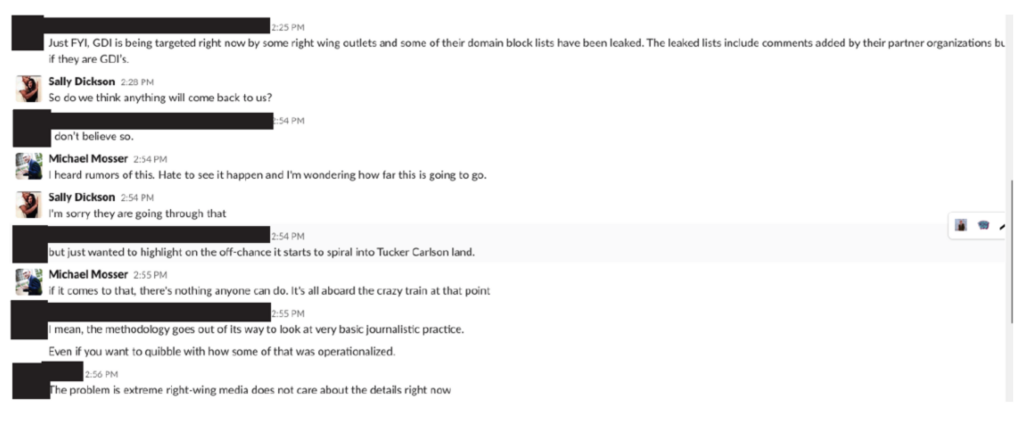State-funded University of Texas managed censorship project targeting conservative outlets
05/28/2023 / By News Editors

The Global Disinformation Index’s report blacklisting conservative outlets, such as The Federalist, New York Post, Daily Caller, and Washington Examiner, as the “riskiest” disinformation media companies was researched and written by students at the University of Texas at Austin’s Global Disinformation Lab, according to documents obtained by The Federalist.
(Article by Margot Cleveland republished from TheFederalist.com)
The academics running the lab held an anti-conservative bias, internal communications show. Those details are among several troubling revelations contained in the 1,000-plus pages of documents reviewed by The Federalist.
Here’s the backdrop and the findings of that review.
Blacklisting of Conservatives Revealed
In early February, the Washington Examiner’s Gabe Kaminsky authored an exclusive titled “Disinformation Inc.” In his first installment of the multi-part series “about self-styled ‘disinformation’ tracking organizations,” Kaminsky reported the Global Disinformation Index’s rating of American news outlets was skewed, with the top 10 supposed “riskiest” outlets being conservative, including American Spectator, Newsmax, The Federalist, American Conservative, One America News, The Blaze, Daily Wire, RealClearPolitics, Reason, and the New York Post. In contrast, the top 10 “least risky” outlets leaned nearly entirely left of center.
Kaminsky stressed that the Global Disinformation Index, or GDI, says its mission is to “remove the financial incentive” to create “disinformation,” with its “core output” being the “dynamic exclusion list” that ranks news outlets based on their supposed disinformation “risk.” GDI then sells subscriptions to its lists to marketing organizations, which pull advertising dollars from the outlets, starving them of funding.
At the time of the Washington Examiner’s report, Xandr, which is owned by Microsoft, used GDI’s exclusion list to limit advertising dollars. Xandr has since reportedly dropped its use of the blacklist.
GDI’s blacklist came under further fire when it was discovered the government-funded National Endowment for Democracy granted GDI more than half a million dollars between 2020 and 2021. The State Department’s Global Engagement Center likewise awarded the GDI $100,000 in taxpayer funds in 2021.
GDI’s Partner in Censorship
The Washington Examiner’s expose focused mainly on GDI and the federal government’s funding of it. But the report ranking the media sites revealed the University of Texas’ Global Disinformation Lab joined the enterprise.
That report said a team of researchers from the Global Disinformation Lab (GDIL) at the University of Texas at Austin conducted the review for the “Disinformation Risk Assessment: The Online News Market in the United States.” It was that report, dated Dec. 16, 2022, that targeted conservative outlets, leading The Federalist to file a public-records request at UT Austin in February 2023 for all communications related to GDIL’s work with the Global Disinformation Index on the U.S. media market review.
While the university withheld the actual methodology and research, citing “confidentiality of trade secrets” and “certain commercial or financial information,” the documents obtained by The Federalist nonetheless reveal several concerning details.
GDIL Did the Dirty Work
The internal documents from the University of Texas’ GDIL show that the Global Disinformation Index, in essence, paid the state university to manage student workers who would then apply the GDI methodology to rate the various media outlets and write the final report.
The students received minimum training for the project. When GDIL struggled to meet the deadlines, the lab manager, Sally Dickson, stepped in to help with the ratings, with everyone rushing the reviews of the various media outlets. At the conclusion of the project, UT Austin retained the surplus funds GDI was paid for the work.
That a handful of students, with limited training, evaluated the media outlets and wrote the report that GDI then marketed to advertisers for blacklisting media outlets — costing the conservative press potentially millions of dollars — is troubling. Even more appalling is that the students used a state-funded lab and the university profited from the project.
Yet even when GDI highlighted the list of “riskiest sites” and “least risky sites” that would appear in the report and asked if GDIL had “any reservations” about being credited in the report, the entire GDIL team responded they had no concerns. In fact, they couldn’t wait to promote the report and GDIL’s involvement.
Also disconcerting is that GDI pitched the project to GDIL with the goal of completing the report before the midterms. In recruiting students for the project, GDIL boasted the “work will be immediately valuable” because GDI wants “this to make waves ahead of the midterms,” suggesting the shared goal was to affect the 2022 election.
Email and text exchanges between Dickson and GDIL Executive Director Michael Mosser, dated after the Washington Examiner story broke, further reveal that GDIL saw nothing wrong with a government institution compiling a blacklist of media outlets since they merely followed the GDI methodology.
Political Bias on Display
Nonetheless, GDIL staff raised concerns in internal communications that the story might reach “critical mass.” Those discussions revealed something else about GDIL leaders: an anti-conservative bias.
One message suggested GDI is “really going to be hammered,” linking to a Washington Examiner piece and highlighting The Federalist, Daily Caller, and New York Post as other entities of concern. The lab manager added a link to a National Review article, noting, “they link to the report which obviously mentions us.”
To that, Moser thanked his colleagues for the links, adding, “I hate going to those sources but good to know.”

In another exchange, a GDIL-connected individual noted that “some right-wing outlets” are “targeting GDI,” to which Dickson replied: “So do we think anything will come back to us?”
Then came a most insightful glimpse into the minds behind GDIL, when the individual told Dickson he or she didn’t think so, “but just wanted to highlight on the off chance it starts to spiral into Tucker Carlson land.”

The GDIL executive director replied: “If it comes to that, there’s nothing anyone can do. It’s all aboard the crazy train at that point.” Mosser continued by noting that “the methodology goes out of its way to look at very basic journalistic practice. Even if you want to quibble with how some of that was operationalized.”
“The problem is,” the GDIL leader continued, “extreme right-wing media does not care about the details right now.”
Even the Kids Saw the Problems
It’s rather rich that GDIL’s executive director defended the methodology, framed disagreements with the report as “quibbles,” and declared the right-wing media don’t care about the details, given that even the students conducting the research saw problems in GDI’s rating system.
When questioned on his experience with the project, one student explained he found GDI’s methodology “to be a little interesting in that it requires reviewers to give subjective scores in response to objective trends in data.” This “breaks down the project’s objectivity,” the student added.
“Also, misinformation isn’t always in the article’s words or the domain’s fact-checking policy, but rather the context in which the article is responding to something,” the GDIL student worker continued, noting that the “misinformation landscape” is dotted with “one-sided … media consumption.”
“For example, a NYT article may not have wrong info,” the student stressed, “but that doesn’t mean they’re not writing with an agenda or certain goals in mind.”

Additional internal communications indicate other students involved in the project also had concerns about the methodology.
More State Department Shenanigans
Beyond GDI’s risk-ratings report, internal communications from GDIL revealed more about GDI’s reach, as well as the State Department’s involvement in promoting censorship activities.
When GDIL first attempted to recruit students for the GDI project, Dickson stressed that GDI works “with governments, policymakers, social media platforms, and adtech companies to defund disinformation.”
“They are instrumental in providing data to a bunch of people that I am not sure if I am allowed to talk about,” the lab manager continued, adding GDI also has formal and informal relationships with “trust and safety teams at various big platforms, the most recently announced partnership is with Twitch.”
This email suggests GDI has (or had) a much larger role in censorship activities than previously known. Also suggestive is an email GDIL received from the Global Engagement Center’s “Academic and Think-Tank Liaison.” That email’s signature line indicates the State Department center had a close relationship with the growing number of universities and think tanks involved in the Censorship Complex.
Another set of emails from the State Department’s Global Engagement Center invited GDIL to participate in a technology pilot, titled “the Ukraine Content Aggregator,” which claims it seeks to “amplify unique and verified content related to the Russian invasion of Ukraine, including war crimes being committed.”
Significantly, for this project, the State Department was working with the Centre for Information Resilience, which is where Nina Jankowicz landed after backlash forced the Biden administration to shutter the Department of Homeland Security’s Disinformation Governance Board, which Jankowicz had been tapped to head.
So Much More to Learn
While these new details raise additional concerns about the government’s funding of efforts to silence speech, The Federalist’s open-records request reveals there is so much more to uncover to understand the breadth and depth of the Censorship Complex fully.
Read more at: TheFederalist.com
Submit a correction >>
Tagged Under:
banned, Censored, Censorship, deception, obey, politics, propaganda, speech police, thought police, Tyranny, University of Texas
This article may contain statements that reflect the opinion of the author
RECENT NEWS & ARTICLES
COPYRIGHT © 2017 TECHNOCRATS.NEWS
All content posted on this site is protected under Free Speech. Technocrats.news is not responsible for content written by contributing authors. The information on this site is provided for educational and entertainment purposes only. It is not intended as a substitute for professional advice of any kind. Technocrats.news assumes no responsibility for the use or misuse of this material. All trademarks, registered trademarks and service marks mentioned on this site are the property of their respective owners.



















